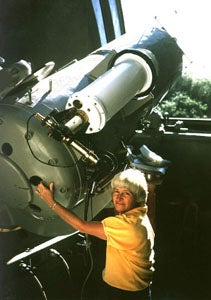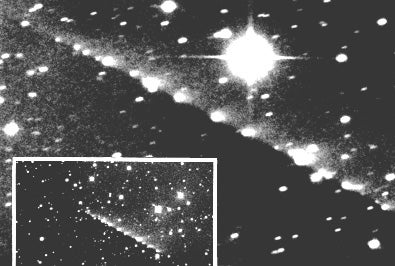Astronomy lost a towering figure on Aug. 13 when Carolyn Shoemaker, one of the preeminent comet and asteroid hunters of her generation, died at age 92.
Shoemaker didn’t take the most conventional path to studying the cosmos — she began studying astronomy at the age of 51. But by the time of her passing, she had left her mark, discovering or co-discovering 32 comets and over 800 asteroids. Among them was one of the most famous comets of all time, Comet Shoemaker-Levy 9 (D/1993 F2), which plowed into Jupiter in 1994. At the same time, Shoemaker also blazed a path for other women to enter the sciences.
Although there was no immediate public confirmation of Shoemaker’s death, word spread quickly through the astronomy community. Her passing was acknowledged in a statement from the Lunar and Planetary Institute (LPI) on Aug. 17. “She was smart, witty, and just so practical,” said LPI director Lisa Gaddis. “She was an example to younger women and budding scientists everywhere as someone who made a difference in her own way.”
Path to the stars
Shoemaker grew up in Chico, California and didn’t have any particular interest in space or even science. At Chico State College, she got her bachelor’s and master’s degrees in history and political science. At a loss for what to do post-graduation, she attempted teaching per her mother’s suggestion but quickly discovered she wasn’t a good fit for the position.
At her brother’s wedding in 1950, she met her future husband Gene Shoemaker, who was then working on a Ph.D. in metamorphic petrology at Princeton University. For a year the two wrote letters to each other, falling in love. In August 1951, they married and moved to Flagstaff, Arizona where they raised three children and Gene Shoemaker established the U.S. Geological Survey (USGS) Center for Astrogeology.
Prior to her marriage, Shoemaker had taken one geology course and hated it, but in a USGS biography, she said “listening to Gene explaining geology made what she had thought was a boring subject into an exciting and interesting pursuit of knowledge.” So, around 1980, when their children had grown up and Shoemaker was looking for something else to devote her time to, she joined her husband on a new project of his at Palomar Observatory.
This first of its kind program was dedicated to looking for near Earth asteroids. While Shoemaker’s first reaction, as she stated in a 2017 interview with radio station KNAU, was, “I don’t think so, I’ve never stayed awake at night in my life,” she began looking at photographs on glass plates of the night sky at the California Institute of Technology and quickly found it to require patience and attention to fine detail, something she believed motherhood had perfectly prepared her for.
Comet hunter
In 1983, when she was in her mid 50s, she discovered her first comet. “It was a really exciting, thrilling experience, because I didn’t think I would ever find a comet,” she said. Though Shoemaker went on to find 32 comets, holding the record as the most comets discovered by a single person for a time, her most famous came in 1993. “I was scanning the film, and then I came across this fuzzy object.” Entirely unlike any comet she had seen before, the object had been captured by Jupiter and torn to pieces — and those pieces were on a collision course with the gas giant’s surface. Named Shoemaker-Levy 9 for its discoverers — the Shoemakers and their colleague David Levy — the comet rained down on the jovian atmosphere for six days and was the first ever observed collision between such massive objects in the solar system.
Even after her husband’s death in 1997, she continued to observe. “My real love for the night skies developed while observing at Palomar Observatory in California, and that love has never diminished.”











